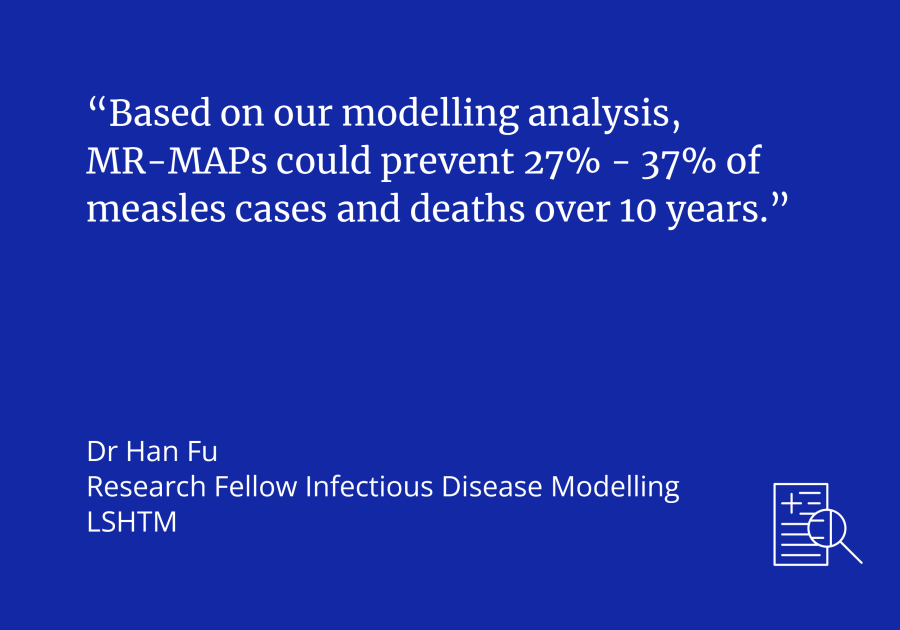
According to a study recently published in BMJ Global Health, the introduction of measles-rubella microarray patches (MR-MAPs) could be a cost-effective strategy to tackle the stagnant coverage of measles and accelerate disease elimination.
A microarray patch (MAP) consists of thousands of tiny projections that deliver the dry vaccine just below the skin surface. The needle-free MAP shows great potential to overcome current vaccine delivery barriers, including reducing requirements for cold chains and increasing acceptance. MR-MAP vaccines are also designed for an integrated single-dose application, which makes it simpler and easier to administer and could reduce potential vaccine wastage and programmatic errors.
Researchers from the London School of Hygiene & Tropical Medicine (LSHTM), in collaboration with the United Nations Children’s Fund (UNICEF) and MMGH Consulting GmbH, assessed the health impact and cost-effectiveness of introducing MR-MAPs in 70 low- and middle-income countries. As part of the initial Full Vaccine Value Assessment (iFVVA) for MR-MAPs, these findings could have broader policy implications, especially for reducing measles outbreaks and disease burden and improving vaccine equity globally.
Dr Han Fu, the lead author from LSHTM, said:
“MR-MAPs is a needle-free vaccine innovation demonstrating great potential in overcoming vaccine delivery barriers in many settings. Based on our modelling analysis, MR-MAPs could prevent 27%ー37% of measles cases and deaths over 10 years from the introduction in 2030. In addition to the substantial health impact, introducing MR-MAPs could also be cost-effective, particularly under stagnant future vaccine coverage and procurement prices similar to existing vaccines.”
According to the study authors, this is the first cost-effectiveness analysis that takes into account the potential use cases of implementing MR-MAPs in country immunisation programmes. Although the clinical development of MR-MAPs is at an early stage, this analysis provides useful information for planning the implementation of MR-MAPs in the future.
Dr Jean-Pierre Amorij, co-author and lead researcher from UNICEF, discussed the development and potential implementation of MR-MAPs:
“Measles anywhere is a threat everywhere. MR-MAP will reduce deaths caused by measles as well as the socio-economic burden of this highly contagious, but vaccine-preventable disease. MAPs are an important platform technology to increase the reach of vaccines, especially for reducing missed opportunities following vaccination and children who reside in hard-to-reach communities, and help us progress towards our ultimate goal of measles elimination.”
The methodology used for modelling the impact of MR-MAPs indicates that the earliest possible supply availability and country uptake of MR-MAPs would provide the biggest health impact. The authors urge key global partners including donors, MAP developers and vaccine manufacturers to continue to establish collaboration and partnerships that strive for the fastest availability of MR-MAPs possible while acknowledging sustainability.
Co-author and managing partner from MMGH, Ms Melissa Ko, further commented:
“Measles and rubella vaccines have one of the highest return on investments yet for years we have struggled to achieve and sustain elimination. The MR-MAP, given its novel characteristics and ease of administration, gives us a chance to remove persistent barriers and reach our goals. ”
This work has been made possible under a longstanding UNICEF partnership with Alwaleed Philanthropies (AP) for measles control and elimination. AP is a global philanthropic foundation which was founded by Saudi Arabian Prince, HRH Prince Alwaleed bin Talal, who is the chairman of AP. Speaking about the assessment, AP Secretary General HRH Princess Lamia bint Majed Al Saud said:
“The number of children around the world still suffering from measles and rubella is astonishing -- but what is more astonishing is how easy it is to prevent these diseases through safe and effective vaccines if you reach these children with potent vaccines. The work on the iFVVA for MR-MAPs shows how an innovative technology, supported by philanthropic partnerships, can contribute to achieving the Sustainable Development Goals -- and to protect some of the most vulnerable children in the world.”
LSHTM's short courses provide opportunities to study specialised topics across a broad range of public and global health fields. From AMR to vaccines, travel medicine to clinical trials, and modelling to malaria, refresh your skills and join one of our short courses today.
